

We may earn revenue from the products available on this page and participate in affiliate programs. Learn More ›
It’s not easy maintaining a lush carpet of green grass. The health of any planted grass that you see above ground depends on factors at play underneath the turf. Aeration is a means of ensuring that air, moisture, and nutrients can reach the roots. There are two ways to tackle the job: The best technique largely depends on the size of your property, but both are discussed in detail below.
Benefits of Lawn Aeration
Like any plant, grass depends largely on root health. The roots need air, water, and nutrients to grow and to support the blades above. As grass grows over time, thatch can build up and become too thick for air and water to seep through. Soil also can become compacted because of heavy foot, machine traffic, soil type, and other causes. Making holes through the top layer of soil with aeration can help:
- Prevent accumulation of excessive thatch
- Encourage stronger roots (which helps stimulate grass growth)
- Improve water penetration, which can reduce pooling of water on the lawn or water runoff and resulting waste
- Increase how much oxygen, water, and nutrients reach the roots
- Reduce soil compaction, especially in areas that get heavy traffic
When to aerate your lawn depends on the type of grass you grow, so plan this task in late spring or early summer for warm-season grasses and in early spring or early fall for cool-season types.
Core Aeration

Most of the best lawn aerators rely on plug, or core, aeration. Homeowners with generously sized lawns can aerate turf using a low-tech mechanical version of a plug or core aerator. As you push the aerator along (or tug it behind your mower), the tool rotates hollow steel spikes into the soil. Those spikes, in turn, pull cylinders of dirt from the soil, leaving small holes in the ground. Core aeration is the best approach for large yards, heavily compacted or clay soil, or for lawns with a thick layer of thatch. Plus aeration also produces longer-lasting effects in your lawn but can cost more than spike aeration.
Types of Core Aerators
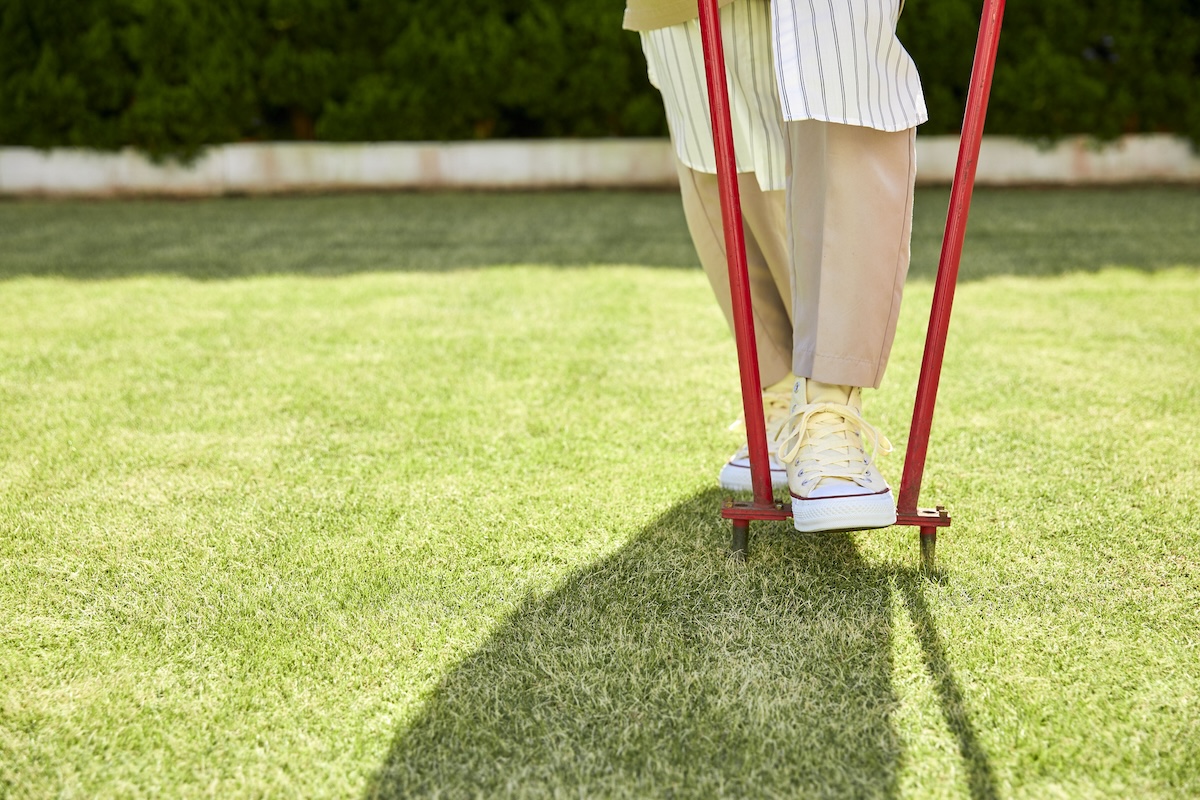
You can buy a manual or handheld core aerator like the Corona 40-inch Composite for about $30. They typically have dual handles and a foothold so you can step on the bottom to push the two or three tines into the soil. These work well for small lawns that need aeration but will require lots of effort in the heaviest or most compacted soils and for medium to large lawns. Most rented core aerators are walk-behind models that work like a lawn mower (and most run on gas). These have about 35 to 40 core tines and can cover a lot of ground (up to 40,000 square feet) in an hour.
Those with properties large enough to need a riding lawn mower can opt for a tow-behind core aerator. These connect to a hitch on the mower. Though they typically don’t penetrate as deeply as a motorized walk-behind aerator, some models like the Brinly-Hardy 40-inch Tow-Behind Plug Aerator include a tray to add weight to the attachment so it can pull up deeper plugs.
How to Use a Core Aerator on Your Lawn

Mow your lawn within a few days of aerating so the tines can reach the soil more easily. The day before you plan to aerate, water the lawn well (apply about an inch of irrigation) to soften the soil (or time the task based on a recent rain). Once you buy or rent the aerator, be sure to check instructions that come with the tool before beginning so you can properly run and set the depth or a walk-behind or tow-behind aerator and following these steps:
- Mark hidden stumps, sprinkler heads, and shallow irrigation, septic, or utility lines to prevent damaging them or the tool. Use landscaping flags, tall stakes driven into the ground, or spray paint.
- Push or pull the aerator to cover the entire lawn in a criss-cross pattern, much like when mowing.
- Check to make sure aeration holes (and the plugs on the surface) are about 2 to 3 inches deep, and that the holes occur about 3 inches apart throughout the lawn.
- If soil shows heavy compaction, go back over the lawn a second time in a perpendicular direction.
- Leave the soil plugs on the ground. Although they look unsightly for a time, they will break down and crumble eventually, adding organic matter back into the soil.
- Water the lawn when done and try to stay off the grass for a few days.
- Fertilize, add soil amendments, or overseed if necessary and water a newly aerated lawn every few days for about 2 weeks.

Tool Tip
Supported by Ecomax
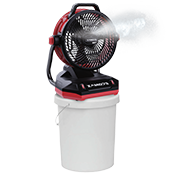
Preparing for a full day in direct sun? Enlist the help of the Ecomax Bucket Top Misting Fan to keep cool while you work outside. The 12-inch cordless fan pulls water from a bucket or garden hose, then disperses a fine mist into the surrounding area for up to 3.75 hours on a single charge (or continuously when plugged into an outdoor-rated extension cord). Two airflow speeds up to 1400 CFM and a 135-degree pivoting head enable it to precisely cool off whatever space you’re working in.
Get the Ecomax Bucket Top Misting Fan at Costco for $134.99.
Spike Aeration
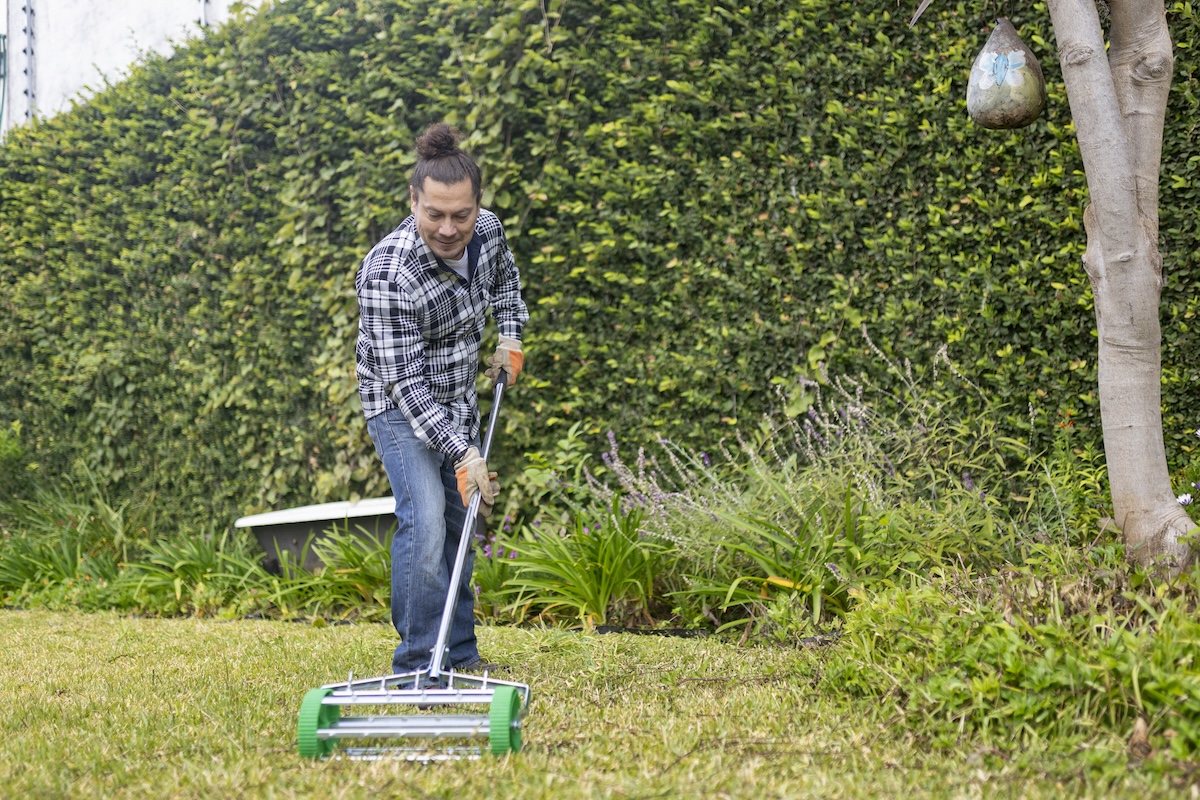
Because it’s more labor intensive, spike aeration is suggested only for homeowners with lawns of small or modest size. It works well on lawns that are sandy or lightly compacted; spike aeration is difficult in soil that is rocky or made up of heavy clay. The tines on a spike aerator are solid, so the tool can jab into the lawn, but does not remove soil or create openings as large as a core aerator does. This can be a more affordable method, since a pitchfork can do the job nearly as well as a handheld spike aerator.
Types of Spike Aerators
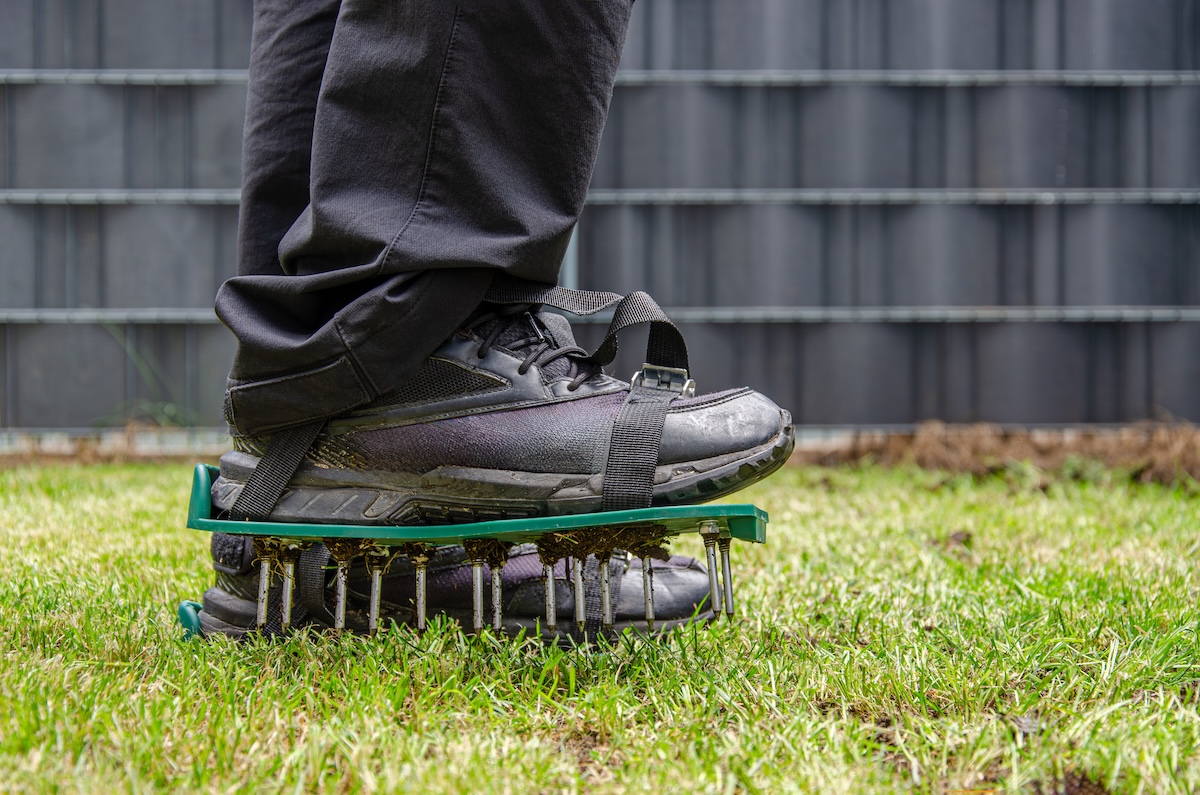
Special spading forks or pitchforks are suitable as spike aerators, but can lack a good surface to place your foot and likely have fewer holes than a tool designed for spike aeration. The manual spike aerator has a T-handle and a flat foothold above 15 spikes. A rolling spike aerator rotates spikes on a drum; it also is an affordable manual aeration tool.
Those with riding mowers might consider buying a tow-behind aerator that has a platform for adding weight to deepen the spikes’ penetration. Finally, spike aeration sandals attach to your shoes and create small holes in the lawn as you walk. It can take a great deal of effort to aerate a lawn with spiked shoes.
How to Use a Spike Aerator on Your Lawn
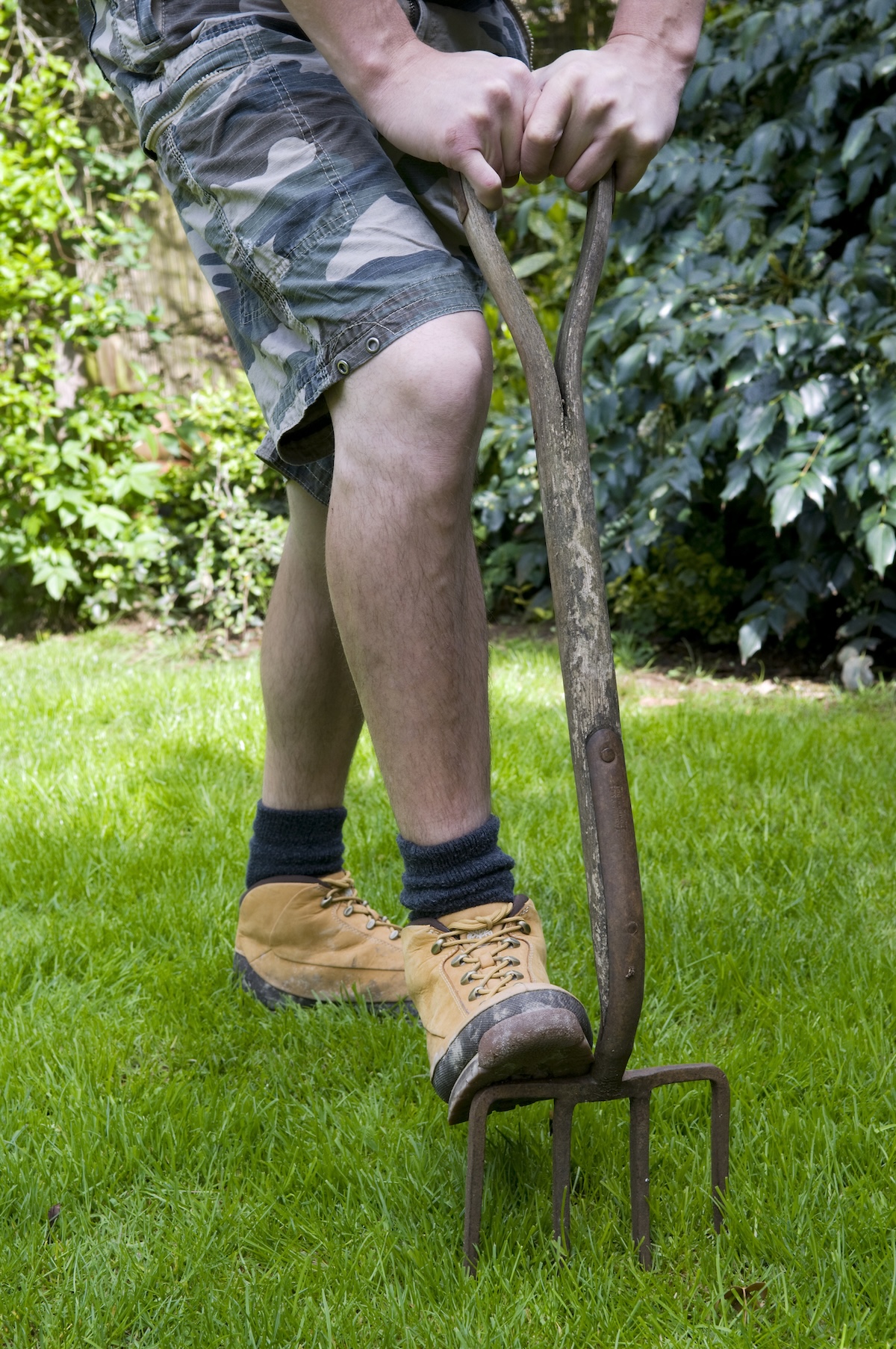
For best results with a spike aerator, take the time to prepare the lawn. Rake and remove all the leaves and debris that might prove to be an impediment. Mow your grass and water the lawn a day or two before using a spike aerator.
- Mark hidden stumps, sprinkler heads, and shallow irrigation, septic, or utility lines to prevent damaging them or the tool.
- With a manual tool such as a pitchfork, step on the top of the tool to ensure its tines penetrate 2 to 3 inches into the soil.
- Choose a corner to start from and work in a straight line across the grass, then turn and travel in the opposite direction, this time working to the side of your previous path. Continue back and forth in this manner until you have aerated the entire property as equally as possible.
- If using a rolling or tow-behind spike aerator, guide the tool much like when you mow to cover the entire lawn.
- Check to ensure the holes are about 3 inches apart and make additional passes or penetrations as necessary.
- Add soil amendments to the surface if necessary and water the lawn when done.

Tried-and-True Advice
Got teenagers? Give them a hand aeration tool and let them get out all of their aggression on the lawn. It’s basically just stabbing spikes into the soil, so their inner conqueror can come out. Put on the Game of Thrones theme to set the mood. This method works well for adults, too.
—Amber Guetebier, Contributing Writer
Final Thoughts
Now that you know how to aerate your lawn, do so every 1 to 5 years to prevent problems from compacted soil and improve grass health. Watch for signs of compaction, thatch, sponginess or poor grass appearance to help determine frequency. If using the spike or core aeration methods above is too daunting a task or fails to resolve problems with your lawn, consider turning to professionals to aerate your lawn. The cost of lawn aeration varies based on your lawn’s size and the type of aeration suggested, but ranges from about $85 to spike aerate a 10,000 square foot lawn to $200 for core aeration.
